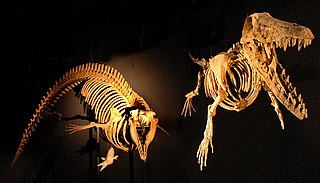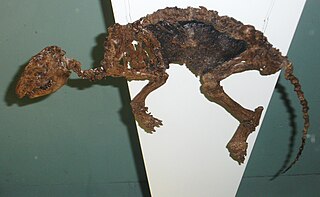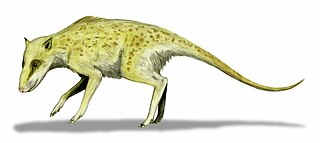Remingtonocetus
| Remingtonocetus | |||||||||||||||||
|---|---|---|---|---|---|---|---|---|---|---|---|---|---|---|---|---|---|
 R. harudiniensis'in yaşam restorasyonu | |||||||||||||||||
| Biyolojik sınıflandırma | |||||||||||||||||
| |||||||||||||||||
| Türler[1] | |||||||||||||||||
| |||||||||||||||||
Remingtonocetus, Eosen döneminde antik Tethys Okyanusu kıyı şeridine endemik olan Remingtonocetidae familyasının erken tatlı su memelilerinin soyu tükenmiş bir cinsidir. Adını doğa bilimci Remington Kellogg'dan almıştır.
Açıklama


Sahni & Mishra 1975, Hindistan'daki Harudi Formasyonu'ndaki Lütesiyen sığ gelgit altı çamurtaşında bulunan tip örneği olan kısmi bir iskelete dayanarak Protocetus harudiensis adını verdi. Kumar & Sahni 1986, protocetus'tan morfolojik farklılıklar nedeniyle onu Remingtononocetus harudiensis olarak yeniden adlandırdı.[2]
Remingtonocetus domandaensis, Gingerich et al. 2001, Pakistan'ın Domanda Formasyonu'ndaki bir Lütesiyen kıyı şeylinde bulunan kısmi bir iskelete dayanmaktadır.[3] Remingtonocetus Andrewsiphius'tan daha büyüktür, daha geniş bir kürsüye ve daha uzun premolarlara sahiptir. Dalanistes'ten daha küçüktür, daha zarif azı dişleri ve küçük azı dişleri vardır. R. harudiensis, azı dişi morfolojisinde R. domandaensis'ten farklıdır.[4]
Gingerich vd. 2001, R. domandaensis'i R. harudiensis'ten daha yaşlı ve daha genel bir tür olarak yorumladı. Morfolojik bir analize dayanarak, Remingtonocetus'un arka bacaklarının muhtemelen ağırlık taşımadığı ve kaynaşmış sakrumun kuyruktan güç alan harekette bir sınırlamaya işaret ettiği ve güçlü kalça ekstansörlerinin ve femoral addüktörlerin varlığına işaret ettiği sonucuna varmışlardır. Bu, Remingtonocetus'un verimli ve uzman bir ayakla çalışan yüzücü olduğunu gösterir.[4]
Remingtonocetus'un dört çalışan ve kullanılabilir ayakları, uzun kuyruğu ve ince, hidrodinamik kafası olan ince balina benzeri bir vücudu vardı.
Taksonomi
Remingtonocetus ismi Kumar & Sahni 1986 tarafından seçildi. Tip türü Protocetus harudiensis'tir. Uhen et al. 2011 tarafından monofiletik olarak kabul edildi. Uhen et al. 2011. Sepkoski 2002 tarafından Cetacea'ya atandı. Kumar & Sahni 1986, Gingerich & Russell 1990, Benton 1993, McKenna & Bell 1997, Bajpai & Thewissen 1998, Williams 1998, Thewissen et al. 2001, Gingerich et al. 2001, Geisler & Sanders 2003, McLeod & Barnes 2008 ve Uhen et al. 2011 tarafından remingnotocetidae'ye atandı.[2]
Ayrıca bakınız
Notlar
- ^ Remingtonocetus, Paleobiology Database. Retrieved 31 March 2013.
- ^ a b Remingtonocetus harudiensis, Paleobiology Database. Retrieved 31 March 2013.
- ^ Remingtonocetus domandaensis, Paleobiology Database. Retrieved 31 March 2013.
- ^ a b Gingerich et al. 2001
Kaynakça
- Bajpai, S.; Thewissen, J. G. M. (1998). "Middle Eocene Cetaceans from the Harudi and Subathu Formations of India". Thewissen, J. G. M. (Ed.). The Emergence of Whales. Advances in vertebrate paleobiology. New York: Plenum Press. ss. 213-233. ISBN 9780306458538. OCLC 300450327. Erişim tarihi: 31 Mart 2013.
- Benton, Michael J. (1993). The Fossil record 2. Chapman & Hall. ISBN 9780412393808. OCLC 27012634.
- Geisler, Jonathan H.; Sanders, Albert E. (2003). "Morphological Evidence for the Phylogeny of Cetacea". Journal of Mammalian Evolution. 10 (1/2): 23-129. doi:10.1023/a:1025552007291. OCLC 361831220.
- Gingerich, Philip D.; Russell, Donald E. (1990). "Dentition of Early Eocene Pakicetus (Mammalia, Cetacea)". Contributions from the Museum of Paleontology, University of Michigan. 28 (1): 1-20. hdl:2027.42/48537.
- Gingerich, Philip D.; Ul-Haq, Munir; Khan, Intizar Hussain; Zalmout, Iyad S. (2001). "Eocene stratrigraphy and archaeocete whales (Mammalia, Cetacea) of Drug Lahar in the eastern Sulaiman range, Balochistan (Pakistan)". Contributions from the Museum of Paleontology, University of Michigan. 30 (11): 269-319. hdl:2027.42/48661. OCLC 742731671.
- Kumar, K.; Sahni, A. (1986). "Remingtonocetus harudiensis, new combination, a middle Eocene archaeocete (Mammalia, Cetacea) from western Kutch, India". Journal of Vertebrate Paleontology. 6 (4): 326-349. doi:10.1080/02724634.1986.10011629. OCLC 4649653943.
- McKenna, Malcolm C.; Bell, Susan K. (1997). Classification of Mammals Above the Species Level. New York: Columbia University Press. ISBN 0231110138. OCLC 37345734.
- McLeod, S. A.; Barnes, L. G. (2008). "A new genus and species of Eocene protocetid archaeocete whale (Mammalia, Cetacea) from the Atlantic Coastal plain". Wang, Xiaoming; Barnes, Lawrence G. (Ed.). Geology and Vertebrate Paleontology of Western and Southern North America (PDF). Science Series, Natural History Museum of Los Angeles County. 41. ss. 73-98. Erişim tarihi: 31 Mart 2013.
- Sahni, Ashok; Mishra, Vijay Prakash (1975). "Lower Tertiary vertebrates from western India". Monograph of the PaleontologicalSociety of India. 3: 1-48. ASIN B0007AL8UE. OCLC 3566369.
- Sepkoski, J. John (2002). "A Compendium of Fossil Marine Animal Genera". Bulletins of American Paleontology. 363. OCLC 207130974.
- Thewissen, J. G. M.; Williams, E. M.; Roe, L. J.; Hussain, S. T. (2001). "Skeletons of terrestrial cetaceans and the relationship of whales to artiodactyls" (PDF). Nature. 413 (6853): 277-81. doi:10.1038/35095005. OCLC 118116179. PMID 11565023. Erişim tarihi: 31 Mart 2013.
- Uhen, Mark D.; Pyenson, Nicholas D.; Devries, Thomas J.; Urbina, Mario; Renne, Paul R. (2011). "New Middle Eocene Whales from the Pisco Basin of Peru". Journal of Paleontology. 85 (5): 955-969. doi:10.1666/10-162.1. OCLC 4804318567.
- Williams, Ellen M. (1998). "Synopsis of the Earliest Cetaceans". Thewissen, J. G. M. (Ed.). The Emergence of Whales. Advances in vertebrate paleobiology. New York: Plenum Press. ISBN 9780306458538. OCLC 300450327.











